"Deserts, Wetlands and Wilderness"
Trip Report by Ian Broadbent
Introduction
This was the first trip to Africa for my wife and I, and it proved to be an excellent introduction to the wildlife and culture of the region. The holiday was organised through Exodus (www.exodus.co.uk) and involved a 3 week overland tour starting and ending in Victoria Falls, Zimbabwe. The tour is marked as their "Deserts, Wetlands and Wilderness" tour, and takes in Chobe National Park and the Okavango Delta in Botswana, followed by Waterberg, Etosha and Namib-Naukluft National Parks in Namibia, before finishing with 3 days in Victoria Falls, where we visited the Victoria Falls NP in Zimbabwe and Mosi-au-Tunya National Park in Zambia.
Transport was by overland truck with 16 other travellers plus 2 leaders, and we camped for all but three days in Namibia and the final 3 days in Victoria Falls where we stayed in backpackers hostels. Food was mostly prepared by the tour leaders with assistance from the rest of the group on the truck's gas stove. All food was paid for by a food kitty (£70 per person) which was more than enough for the three weeks and also paid for a couple of restaurant meals. Flights were arranged through Exodus; we flew on British Airways from Aberdeen down to London Gatwick, then Air Zimbabwe to Victoria Falls via Harare.
This was not intended to be an all out birding holiday, and so some key sites were not visited and a few of the Namibian endemics missed, but the tour still facilitated a lot of great birding and game viewing and we had a wonderful time. We ended up with a bird list of 318 species and a mammal list of 40, both of which exceeded all expectations considerably. The species list was greatly topped up in Victoria Falls with the expert assistance of local birder Chris Pollard, who can be contacted via email at pollardcjw@yahoo.com -his Zambesi boat trip costs US$10 and is well worth it, although his small boat can only take one passenger. However he can arrange boat trips for larger groups, and will tailor-make a day's itinerary according to your needs. Chris' rates are US$5 per hour to a maximum of $60, plus fuel charges of 20cents per km outside the municipality of Victoria Falls.
Most of the group experienced minor stomach upsets during the trip (mostly cured by Immodium), but some of the group also went down with flu-like symptoms for a couple of days, which thankfully Gill and I avoided. We took Malarone anti-malarial pills daily, and got the usual jabs before we left the UK (typhoid, hepatitis, tetanus etc). Insect bites were nowhere near as bad as we expected; this was probably due to the time of year (September is towards the end of the dry season). However, the one night where we slept out in the open (at Abu Huab), I forgot to put repellent on and was bitten 10+ times on my face. Nice! It is advisable to take (and use!) repellent with as much DEET as you can get, although remember that DEET and cameras/binoculars do not mix.
A quick note about money; we took far too much in US$ travellers cheques and hence got a crap exchange rate particularly in Victoria Falls, where hard currency (US$ or £ sterling) would have effectively doubled our money. Also make sure you have the correct money for the Zimbabwe airport departure tax (US$20 at the time of writing, but check when you arrive) - they don't give change.
The books I took were the Collins Illustrated Checklist of Birds of Southern Africa by Ber van Perlo, and Haltenorth and Diller (1977) A Field Guide to the Mammals of Africa including Madagascar (Collins). The Ian Sinclair guide for the birds looks pretty good, but the Collins was adequate for most purposes. As a first-timer in Africa, the biggest identification challenges were posed by the non-breeding plumages of the weavers and widows etc., cisticolas, sunbirds, larks and some of the starlings - quite a few of these birds remained unidentified!
The report is arranged into 5 main sections, Introduction, Itinerary, Daily Diary, Systematic Bird List and Systematic Mammal List. Any mistakes or omissions in this report are entirely my fault; please feel free to contact me (i.d.broadbent@abdn.ac.uk) to point them out or ask about any aspect of the trip.
Itinerary:
Saturday 8/9/01: Departed Aberdeen mid-morning, long wait at Gatwick before overnight flight to Harare, Zimbabwe.
Sunday 9/9/01: Arrived Harare and met up with the rest of the group; flew to Victoria Falls to rendez-vous with the truck and trip leaders; short drive to Kasane, Botswana, on the edge of Chobe NP.
Monday 10/9/01: Morning game drive in Chobe, followed by afternoon/sunset game cruise along the river.
Tuesday 11/9/01: Long drive from Kasane to Maun via Nata.
Wednesday 12/9/01: Early morning flight over the Okavango Delta to Seronga. Mokoro (canoe) cruise to bush camp in the Delta.
Thursday 13/9/01: Morning game walk then mokoro back to Seronga; speedboat to Sepupa to meet up with the truck again.
Friday 14/9/01: Long drive south from Sepupa to Namibian border at Mamuno via Ghantzi; camp at Windhoek, Namibia.
Saturday 15/9/01: Drive from Windhoek to Waterberg NP. Late afternoon walk to the plateau.
Sunday 16/9/01: Drive to Etosha NP via the Hoba meteorite. Late afternoon game drive in eastern Etosha; camp at Namutoni.
Monday 17/9/01: Full day of game drives in Etosha; via Halali camp to Okaukejo camp. Stayed up overnight to watch the Okaukejo waterhole.
Tuesday 18/9/01: Left Etosha to drive to Petried Forest via Khorixas; on to rock paintings at Twyfelfontein; night under the stars at Abu Huab camp.
Wednesday 19/9/01: Abu Huab to Skeleton Coast, Cape Cross seal colony. Inland to bush camp at Spitzkoppe.
Thursday 20/9/01: Spitzkoppe to Swakopmund; afternoon watching skydiving. First of 2 nights in a bed at Villa Wiese hostel.
Friday 21/9/01: Morning Walvis Bay dolphin cruise; afternoon in Swakopmund.
Saturday 22/9/01: Drive inland to Sesriem in Namib-Naukluft NP; sunset at Dune 45 near Sossusvlei.
Sunday 23/9/01: Sesriem to Rehoboth; stayed in chalets at Rehoboth hot spa.
Monday 24/9/01: Long drive from Rehoboth to Maun via Windhoek; camp at Maun.
Tuesday 25/9/01: Long drive Maun to Victoria Falls via Nata and Kazungula. First of 3 nights in a chalet at Shoestring Backpackers hostel in Vic Falls.
Wednesday 26/9/01: Early morning walk to Victoria Falls NP; afternoon walk to watch bungi jumping; night game drive near Vic Falls.
Thursday 27/9/01: Early morning boat trip with Chris Pollard on the upper Zambesi followed by birding at the golf course, sewage ponds and Gorges Lodge. Mid-afternoon/evening game drive in Mosi-au-Tunya game park in Zambia with Tony Simpson of Baantu.
Friday 28/9/01: Morning walk around Vic Falls area/last minute shopping before early afternoon flight to Harare. Overnight flight to Gatwick.
Saturday 29/9/01: Early afternoon flight to Aberdeen.
Diary
9th September: We arrived at Harare airport with no major hold-ups, and the first birds of the trip were Pied Crows around the main terminal, closely followed by large numbers of Little Swifts and a distant Black-shouldered Kite which provided a good distraction while we waited for our connection to Vic Falls. We met up with most of the other travellers here, before taking the short flight to Vic Falls where we were picked up by the two Exodus leaders. We made an immediate start out towards Chobe, via the Kazungula border post, and birds were fairly easy to come by, the pick of which was a young Bateleur at the border. Roadside Chacma Baboons also reminded us that we were quite a long way from Aberdeen. We reached the Chobe Safari Lodge by mid-afternoon, a delightful campsite right by the riverside (we were told to be careful of hippos and crocs!). I started to get familiar with some of the starlings and weavers around the campsite, and I managed to scope a few distant waterbirds including African Darter. Our first African Fish Eagles circled noisily around, and a flock of Carmine Bee-eaters overhead was only just bettered by Gill finding a White-browed Robin Chat (Heuglin's Robin) - a right little jaw-dropper. A pair of Brown-hooded Kingfishers around the terrace were a perfect accompaniment to my first bottles of Castle lager, which I thought were having an early effect when a distant mound of earth started to move across the plain - scoping revealed it had a trunk on its front end, the first of many, many Elephants. Our first dinner around the campfire was great fun meeting our fellow truckmates, and our first night in the tent was only interrupted by the grunting sounds of Hippos on the river outside.
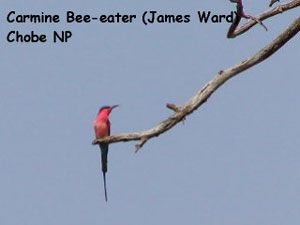 10th September: We made a dawn start for a game drive around Chobe, and the birds came thick and fast; the only Chinspot Batis of the trip was at the entrance to the park, Red-billed Hornbills were all over and a Hooded Vulture stood on the road tucking into some Lion droppings. Game included Kudu, Impala and large herds of Elephant, and when we reached the river plain itself it was a case of where to look next. Flocks of Guineafowl, francolins, plovers, storks, Spur-winged Geese, White-faced Whistling Ducks to name but a few, however the best was yet to come. As we made our way along the side of the plain, I caught the unmistakable frame of a Lioness ambling towards us - but the driver had located an even closer lioness sat under the shade of the trees. We had fantastic views of these, plus another two distant lions that were making a rather laughable attempt to stalk a couple of Cape Buffalo. A short distance later we caught up with the rest of the pride lazing around within a few feet of the truck, snoozing in the shade. Not to be outdone by the mammals, the birds also started to turn up trumps with a group of African Skimmers doing their thing along the river, the first of many Hamerkop, a couple of Trumpeter Hornbills, and best of all were two Crimson-breasted Bush Shrikes ! On the way back we were entertained by Carmine Bee-eaters and a large herd of Elephants, some of which crossed the road in front of us.
10th September: We made a dawn start for a game drive around Chobe, and the birds came thick and fast; the only Chinspot Batis of the trip was at the entrance to the park, Red-billed Hornbills were all over and a Hooded Vulture stood on the road tucking into some Lion droppings. Game included Kudu, Impala and large herds of Elephant, and when we reached the river plain itself it was a case of where to look next. Flocks of Guineafowl, francolins, plovers, storks, Spur-winged Geese, White-faced Whistling Ducks to name but a few, however the best was yet to come. As we made our way along the side of the plain, I caught the unmistakable frame of a Lioness ambling towards us - but the driver had located an even closer lioness sat under the shade of the trees. We had fantastic views of these, plus another two distant lions that were making a rather laughable attempt to stalk a couple of Cape Buffalo. A short distance later we caught up with the rest of the pride lazing around within a few feet of the truck, snoozing in the shade. Not to be outdone by the mammals, the birds also started to turn up trumps with a group of African Skimmers doing their thing along the river, the first of many Hamerkop, a couple of Trumpeter Hornbills, and best of all were two Crimson-breasted Bush Shrikes ! On the way back we were entertained by Carmine Bee-eaters and a large herd of Elephants, some of which crossed the road in front of us.
We headed back to the camp in fine spirits after such a great start, and after lunch we had time for a few beers and I wandered around the camp to catch up with some more of the campsite birds, including the only Square-tailed Drongo of the trip. A troop of cheeky Vervet Monkeys tried to steal food from the truck while I was being distracted by Tropical Boubous. A group of circling White-backed and Hooded Vultures also included an adult Cape Griffon Vulture, which is becoming increasingly scarce in this part of Africa. Mid-afternoon saw us set out on a double-decker boat cruise along the river, and the birds and game rivalled the morning's game drive. A pair of Giant Kingfishers along the riverbank was one of many highlights, but perhaps the most memorable experience was watching a family group of Elephants negotiate a river crossing. Nile Crocodiles lined the banks, and a group of Hippos wallowed in a waterhole. We saw the same pride of Lions again from a distance, and they seemed a little more active in the late afternoon. Waterbuck, Puku and Red Lechwe were amongst the numerous ungulates on the plain, whilst notable birds included Water Dikkop, White-fronted Bee-eater and Swainson's Francolin. We headed back to the lodge after sunset to reflect on a stunning first full day over a few bottles of Castle.
11th September: This darkest of days started innocently enough with a stroll outside the camp towards the main drag in Kasane. I picked up quite a few new species including the only Bearded Woodpecker and Southern Black Tit of the trip, before it was time to join the truck and head off on the long journey to Maun via Nata. Roadside birds and pitstops en route produced our first Southern Ground Hornbill, a White-headed Black (Arnot's) Chat, White-crowned Shrike, Magpie Shrike and numerous hornbills (Red-billed, Yellow-billed and African Grey) as well as more Elephants. Just west of Nata we saw our first Ostriches, although these were likely to have been of feral stock. Nearer to Maun I found a couple of Capped Wheatears, and the first Burchell's and Southern Long-tailed Starlings. The campsite at Maun had lots of Red-billed Francolin, Red-billed Buffalo Weavers, Arrow-marked Babblers and a Southern Pied Babbler, but shortly after we got the tents up our driver came back from the bar where he'd seen the first CNN reports from New York. 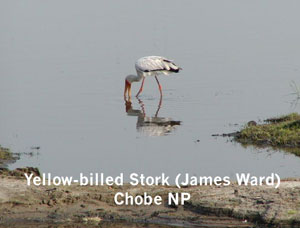
12th September: Tried to clear my head a little with a walk around the camp, a very confiding Kurrichane Thrush strutted up the path to say hi, and a Golden-tailed Woodpecker, two Hoopoes and a Brown-headed Tchagra were all new to the trip list. We then drove out to the airstrip at Maun to take an early morning flight over the Okavango Delta. Crowned Plovers paraded alongside the runway, and pretty soon we were enjoying great views of this enormous inland delta. Someone said that the delta was roughly the same size as Wales, and probably just as soggy! We were low enough to identify mammals below (some people saw Giraffe and even Spotted Hyaena) and I picked out three pairs of Wattled Cranes, a Saddle-billed Stork and a flock of all-dark egrets. On arrival at Seronga we drove through the village past a couple of Magpie Shrikes to the "put-in" for the mokoro safari. Whilst we were introduced to our guides a flock of Meyer's Parrots zoomed around, and Black-headed Oriole and Yellow-throated Petronia were also added. The mokoro safari (they use fibreglass canoes instead of wooden ones these days) was incredibly peaceful, and although we were low down we saw an incredible variety of birds. We were in the lead mokoro with a guide who seemed to really know his stuff, so we got excellent views of any bird that we flushed out of the reeds, including several Lesser Jacanas, Black Egret, the rare Slaty Egret, and three African Pygmy Geese. Swallows and martins were much in evidence, and on the banks we saw another Southern Ground Hornbill, several Black-collared Barbets, and Coppery-tailed Coucal. Raptors included a Dickinson's Kestrel, Long-crested Eagle, Brown Snake Eagle, Gymnogene, African Fish Eagle and Hooded Vulture.
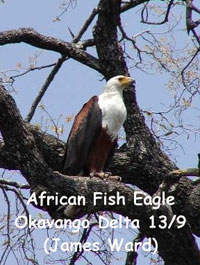 A Saddle-billed Stork gave a spectacular low flypast, and Carmine Bee-eaters were numerous. Pied Kingfishers were abundant, but we also had a few sightings of the more elusive Malachite Kingfisher. We arrived at the bush camp in the middle of the delta, and after setting up our tents we headed back out on the mokoros to a Hippo pool, and enjoyed close views of these fearsome beasts. A short walk produced Red Lechwe, more Wattled Cranes, another Saddle-billed Stork, African Marsh Harrier, the local race of African Snipe and a Marsh Owl. Red-shouldered Whydahs reminded me somewhat of American Red-winged Blackbirds, and various cisticolas (including Chirping, Winding, Rattling and Zitting!) provided more of an identification challenge. Back at the camp a huge flock of Carmine Bee-eaters had assembled, which had turned a distant row of trees a vivid shade of pink. We were told not to leave our tents during the night, as Lions, hyaenas, elephants and hippos all frequented the area, although we only heard the latter. We were glad of our decision to bring sleeping bags, as the temperature was unseasonally cold!
A Saddle-billed Stork gave a spectacular low flypast, and Carmine Bee-eaters were numerous. Pied Kingfishers were abundant, but we also had a few sightings of the more elusive Malachite Kingfisher. We arrived at the bush camp in the middle of the delta, and after setting up our tents we headed back out on the mokoros to a Hippo pool, and enjoyed close views of these fearsome beasts. A short walk produced Red Lechwe, more Wattled Cranes, another Saddle-billed Stork, African Marsh Harrier, the local race of African Snipe and a Marsh Owl. Red-shouldered Whydahs reminded me somewhat of American Red-winged Blackbirds, and various cisticolas (including Chirping, Winding, Rattling and Zitting!) provided more of an identification challenge. Back at the camp a huge flock of Carmine Bee-eaters had assembled, which had turned a distant row of trees a vivid shade of pink. We were told not to leave our tents during the night, as Lions, hyaenas, elephants and hippos all frequented the area, although we only heard the latter. We were glad of our decision to bring sleeping bags, as the temperature was unseasonally cold!
13th September: Breakfast around the camp fire and then a walking safari. Less than 50m from our tents we walked right up to a pair of Grant's Zebra. There were also lots of fresh elephant tracks not too far away! No new birds, but good views of Black-headed Oriole, Bateleur, Carmine Bee-eater and another Marsh Owl flushed from the ground. We headed back to Seronga in the mokoros, with the main highlight being an adult Pink-backed Pelican circling above us. Other than that we saw pretty much the same as the day before, with the same group of 3 African Pygmy Geese, Southern Ground Hornbill, Malachite Kingfisher and Rufous-bellied Heron being amongst the highlights. From Seronga we bade farewell to our excellent mokoro guides and headed out on speedboats across the panhandle to Sepupa, where we were to meet up with the truck again. The campsite at Sepupa had a small waterhole which attracted Red-billed Firefinches and Blue Waxbills, and above the bar were a pair of Green Pigeons and a Crested Barbet. The rubbish dump attracted 3 Bradfield's Hornbills which allowed fairly close approach, as did the numerous Magpie Shrikes. A sunset cruise produced several Malachite Kingfishers, the ubiquitous Carmine Bee-eaters, a Little Bittern and a couple of Senegal Coucals.
14th September: Very early start for one of the longest drives of the trip. We headed south towards Ghantzi where Pale Chanting Goshawks became evident at the roadside, then across towards the Namibian border at Mamuno. White-winged Black Koorhaans and Crested Bustards were also seen en route, along with Southern Anteater Chats and the first Black Crows of the trip. The petrol station just before the border had a water sprinkler that attracted various canaries, weavers and waxbills, and the border post itself was made all the more interesting by a Shikra that perched on a fence in right in front of me. The first bird we saw in Namibia was a Black-breasted Snake Eagle, but not too much else of interest before night fell just as we got into Windhoek. We camped at the Arabusch Travel Lodge just on the edge of town, and got taxis into the centre for a great night at German-style Bierkeller that did a very nice medium-rare Kudu.
15th September: Early morning walk around the campsite was extremely productive with several new birds, including White-backed Mousebird, Scimitarbill, Swallow-tailed Bee-eater, Black-chested Prinia, Chestnut-vented Warbler, Chat Flycatcher, Scarlet-chested Sunbird, Dusky Sunbird and Scaly-feathered Finch, alongside old favourites like Crimson-breasted Bush Shrike. We headed into Windhoek town centre to change some travellers cheques, and the larger hotels and buildings seemed to swarm with Little Swifts (but no Bradfield's here). From here we headed north to Waterberg Plateau, and en route a large roadside raptor smacked of Martial Eagle, but I didn't get enough on it to be sure. The entrance road to the campsite produced our first Monteiro's Hornbills, an Angolan/Namibian speciality. We walked along some of the trails eventually to a look-out at the top of the plateau, well worth the climb for the spectacular views across the plain (and my first Familiar Chat). Birding here was a little disappointing, with no Carp's Tit, Rockrunner or Hartlaub's Francolin, but we just didn't have enough time to do the place justice. Rock Hyraxes scurried about at the base of the cliffs, and another Shikra darted through the canopy. Swifts were numerous, mostly Alpine with a few Bradfields. We bumped into a couple of Rueppell's Parrots, another speciality of the region, on the way back down to the tents.
16th September: Another productive morning walk along the entrance road, with new birds including three Groundscraper Thrushes, White-browed Scrub Robin, Pied Barbet, Rosy-faced Lovebird, Yellow-bellied Eremomela, Grey-backed Cisticola, Marico Sunbird and Violet-eared Waxbill. Southern White-Crowned Shrikes were very approachable in the campsite, but probably the thing that put the biggest smile on my face was a Bushveld Elephant Shrew. Of all the places we visited on the trip, Waterberg was the place where I felt I missed out on most species, as we just didn't have enough time - I had maybe less than 4 hours of daylight to bird there! We headed out of the park, north towards the giant Hoba Meteorite. I was a little underwhelmed with the great lump itself, although the surrounding gardens had lots of canaries, waxbills and sunbirds. On the approach to the meteorite a couple of people on the truck saw a bird that they thought I was also looking at. I was actually watching a kestrel, but from their descriptions the kestrel must have flown directly over a Secretarybird, on the edge of a burnt stubble field. By the time we'd worked out what they'd seen it was several miles away, so I just hoped that Etosha would turn up trumps for me! Just inside the entrance gate at Etosha we saw the first of many Giraffes, but not too many birds on the road up to Namutoni Camp. How that was to change! 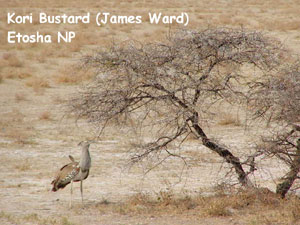 After setting up our tents, we took the truck out on a game drive around the waterholes in the east of the park, which proved to be probably the most productive game drive of the whole three weeks. No sooner had we left the campsite when we saw the first of an incredible 99 Kori Bustards over the next 2 days, and a juvenile Martial Eagle perched at the roadside. Game animals were everywhere, with Burchell's Zebra, Giraffe, Springbok, Oryx (Gemsbok), Wildebeest and Elephant all common. I managed to claw back Secretarybird, with two of these bizarre crane-like raptors strolling across the grass land. I turned round to see 4 Blue Cranes feeding alongside more Kori Bustards, and a Pale Chanting Goshawk landed on the road in front of us. Other roadside birds included a Greater Kestrel, and two Spotted Dikkops. Across the pan, we could see the occasional Ostrich - probably the only wild Ostriches of the trip? We encountered several Black-backed Jackals, and a wary Giraffe pointed the way to a couple of Spotted Hyaenas. It was almost too much to take in! A superb buffet dinner followed, but the wind was starting to pick up so we didn't spend too long at the waterhole, although the floodlights revealed a Cape Shoveler. During the night the heavens opened, and the tent got a little damp - this was the first rainfall for months. Just our luck!
After setting up our tents, we took the truck out on a game drive around the waterholes in the east of the park, which proved to be probably the most productive game drive of the whole three weeks. No sooner had we left the campsite when we saw the first of an incredible 99 Kori Bustards over the next 2 days, and a juvenile Martial Eagle perched at the roadside. Game animals were everywhere, with Burchell's Zebra, Giraffe, Springbok, Oryx (Gemsbok), Wildebeest and Elephant all common. I managed to claw back Secretarybird, with two of these bizarre crane-like raptors strolling across the grass land. I turned round to see 4 Blue Cranes feeding alongside more Kori Bustards, and a Pale Chanting Goshawk landed on the road in front of us. Other roadside birds included a Greater Kestrel, and two Spotted Dikkops. Across the pan, we could see the occasional Ostrich - probably the only wild Ostriches of the trip? We encountered several Black-backed Jackals, and a wary Giraffe pointed the way to a couple of Spotted Hyaenas. It was almost too much to take in! A superb buffet dinner followed, but the wind was starting to pick up so we didn't spend too long at the waterhole, although the floodlights revealed a Cape Shoveler. During the night the heavens opened, and the tent got a little damp - this was the first rainfall for months. Just our luck!
17th September: Sadly the weather did not improve greatly through the morning. However, we went for an early game drive and came across a Spotted Hyaena defending a Springbok carcass from a couple of jackals, plus more Kori and Crested Bustards, Tractrac Chat, and many more game animals. Unfortunately the weather meant that for long periods we had to pull down the clear plastic sides of the truck, which didn't make for good game viewing. At Halali camp things started to brighten up a little, and three Violet Woodhoopoes flew past. A Gabar Goshawk was another flypast in the camp. En route to Okaukejo I found a Double-banded Courser strolling amongst a group of Zebra, and an adult Lappet-faced Vulture at a roadside nest was the other main birding highlight. A group of thirty-plus Elephant at a waterhole offered yet another opportunity to shoot more film. We got into Okaukejo camp just half an hour before dusk, and we parked up near to the famous Sociable Weaver nest (it has grown so big it is now supported by a large wooden post). We headed straight down to the waterhole, and a Spotted Eagle Owl was the first thing I clapped eyes on - what a start! There were no mammals at the waterhole initially, probably due to the noisy groups of tourists on the benches. However, just after dusk a group of 10 Double-banded Sandgrouse came in to drink (we had arrived too late for the other species of sandgrouse, which normally drink by day). At least four Rufous-cheeked Nightjars hawked around the waterhole, and two Barn Owls were active more or less all night. At about 8.30pm, we were thinking of heading back to the truck for some food, when we spotted an animal approaching the waterhole. In the murk I could make out a pair of ears, and then a horn! This was the first of four Black Rhinos that we saw, a young male, and these were my favourites of all the mammals we encountered. After dinner we went back to the waterhole, and spent all night watching the comings and goings. First was another Black Rhino, an adult male, then a female with a very young calf in tow - a very special moment indeed. Gill spotted a bird drop down behind a log, which eventually revealed itself to be a Verreaux's (Giant) Eagle Owl, a really spectacular bird, which gave us a great show. Various other mammals came down to drink during the night, including Springbok, Zebra, Giraffe, Spotted Hyaena, and a herd of thirty Elephants that loomed like huge grey ghosts out of the darkness. Lions had been reported there the previous night, but they didn't put in an appearance unfortunately. A Marsh Owl landed briefly at the side of the water, but it was rapidly chased off by the Barn Owls. A mouse ran along the bench beside us, and the nightjars churred away as we kept up our watch through the small hours.
18th September: Just before dawn the Double-banded Sandgrouse returned, and other birds included several Cape Sparrows and a lone Rufous (Great) Sparrow. Just as we were packing up a little old lady came up to me and asked if I could help her identify a bird for her. Just outside her chalet, right out in the open, was the Verreaux's Eagle Owl again! I filmed it for a couple of minutes, before its piercing stare made me chicken out and move back a few paces before it had me for breakfast! Just before we left the camp, I returned to the Sociable Weavers nest, and hit upon another major target bird, a female Pygmy Falcon. These cracking little birds actually nest inside Sociable Weaver nests! Again, we had to leave too soon, but Etosha hadn't disappointed us. The drive from Okaukejo to the park gate produced a group of forty White-backed Vultures at a dead giraffe, which had also attracted three Lappet-faced Vultures. A Bat-eared Fox at the roadside was a surprise parting shot. After the highlights of Etosha, the rest of the day was a bit of a comedown, and the Petrified Forest near Khorixas was a bit of a dud. Much better were the ancient petroglyphs of Twyfelfontein, but the attractive Mountain Wheatear was the only new bird of the afternoon. We made camp at the Abu Huab bush camp, and whilst supping a beer outside the bar we were pretty stunned to see a Desert Elephant stroll through the camp! This population of Elephant is rarely encountered according to our guides, and it was a bit unnerving to see one so close to the open-ended A-frames where we were to spend the night under the stars.
19th September: Overslept a bit so there was no time for an early walk, we had to start out early to get across to the Skeleton Coast. A more barren, desolate, God-forsaken place you could not imagine! Most of us were tucked into our sleeping bags as we drove along to try and keep warm as the wind blew in off the coast into the truck. Near Toscanini we stopped to look at a shipwreck, so it gave me the first real opportunity to check out the seabirds. At least 3 White-chinned Petrels were seen close inshore, a larger bird than I had envisaged, and a Swift Tern flew south. Lines of Cape Cormorants flew past, and Kelp Gulls patrolled the shore. A small coastal pool had 15 Curlew Sandpipers, a Little Stint and two White-fronted Plovers. We headed south to the Cape Fur Seal colony at Cape Cross - it has to be smelled to be believed! Kelp, Grey-headed and Hartlaub's Gulls were all seen here, as was a Northern Giant Petrel loafing offshore - a bird that I was less than half-expecting. In the bay I also picked out 3 Wilson's Storm-petrels. A Cape Wagtail wandered around the seals, which were blocking the gate to the toilets. After 45 minutes or so the group had had enough of the stink, so we headed inland to Spitzkoppe, arriving just before sundown. A couple of Rueppell's Koorhaans were seen from the entrance track, and Alpine Swifts circled the cliffs. We climbed a short way up the rocks to watch the sunset, another spectacular end to the day.
20th September: Another place where we didn't spend enough time, but an early walk produced two White-tailed Shrikes (a very attractive Namibian/Angolan speciality), a pair of Layard's Warblers, White-throated Canary, Sabota Lark and another two Rosy-faced Lovebirds. Unfortunately, Herero Chat and Rockrunner both eluded me - guess I'll just have to wait until next time! We made our way west to Swakopmund, where we stayed in a half-finished guest house (Villa Wiese), and we spent the afternoon drinking and watching some of the group as they went skydiving.
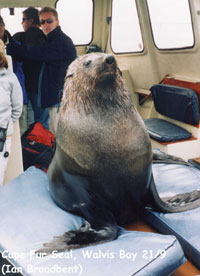
21st September: We had arranged a boat trip through Mola Mola safaris, and they sent someone to pick us up and drive the 30km or so south to Walvis Bay to meet up with the Gambit. We had barely set sail when a Cape Fur Seal launched itself out of the water into the middle of the boat! We were face to face with a 180kg fish-hungry beast that wouldn't take no for an answer. Fortunately our skipper had plenty of fish, and eventually "Flipper" left us to get on with some birding and cetacean-spotting.
We had several close views of White Pelicans, and pretty soon there were lots of Wilson's Storm-petrels around the boat. Two less friendly seals jumped into the boat and started to fight, which was a bit disconcerting! No sooner had they jumped off than somebody shouted "Penguin!", and sure enough there was an adult Jackass Penguin, one of four that we saw on the boat trip - another bird I was less than half-expecting. As we headed towards the tip of the sand bar that runs along the western edge of the lagoon, I picked out a group of five African Black Oystercatchers on the shore, another major target bird. A small pod of Heaviside's Dolphins began to bow-ride - this Benguela Current speciality is only found along 1600km of the south-west African coast line. Another Jackass Penguin allowed us to circle around it at close quarters. Along the shoreline were thousands of Greater Flamingos (couldn't pick out any Lessers unfortunately), various terns and waders, and I picked out a diminutive Crowned Cormorant on a pier. Cape Gannets and White-chinned Petrels were also present in small numbers, and "Flipper" made another surprise appearance on board, before our skipper got the champagne and oysters out for lunch. We headed back to shore, from where I scoped a couple of young Jackass Penguins, and spectacular numbers of birds filled the lagoon. We got a lift back to Swakopmund, where we wandered around the shops for a while, then headed out to the beach and the small lagoon just south of the town, where we spent a while finding out how the Red-knobbed Coot got its name. We spent the evening eating and drinking far too much - no change there then!
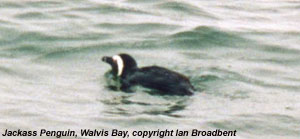 | 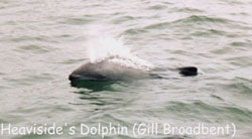 |